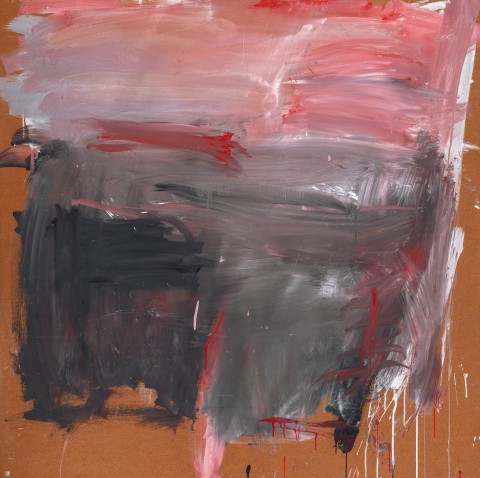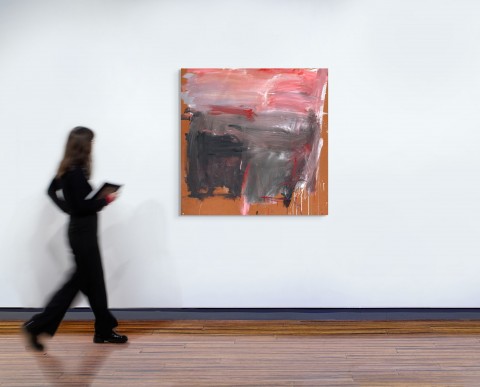UNTITLED, 1970 - 73
TONY TUCKSON
synthetic polymer paint on composition board
121.0 x 121.5 cm
Estate of the artist
Watters Gallery, Sydney
James Wolfensohn, New York
Watters Gallery, Sydney
Private collection, Sydney
Martin Browne Fine Art, Sydney
Company Collection, Sydney, acquired from the above in 1997
Tony Tuckson 1921 – 1973: a memorial exhibition, Pinacotheca, Melbourne, 13 – 30 October 1982, cat. 89 (as ‘1982 No 89’, illus. in exhibition catalogue, p. 32)
Tony Tuckson’s late paintings have remained a distinctive marker in every art historical account of Australian abstraction.
Untitled, 1970 – 73 is not only remarkable because of its clear stylistic connection with other late master works, but also the subtle echoes it holds from Tuckson’s first painterly abstractions. We are familiar with his whispering veils and sweeping gestures, a quickly executed lyricism common in his large diptychs and overlayed with bold single calligraphic actions. Our work complements Yellow, 1970 – 73 (National Gallery of Victoria), but in Untitled, 1970 – 73, the accentuations remind us of the striking red, black and white works of a decade earlier. Tuckson’s art is always underpinned by his past, reshaped and reinforced by contemporary experience.
In Tuckson’s final decade, he all but abandoned his much-admired figurative work inspired by the School of Paris and an expressive abstraction took hold. But the deftness of Matisse and the boldness of Picasso’s single-brushed gestures remind us of the formative influences that helped shape his natural temperament. Further encounters were of great importance and gave momentum to his final work. In 1967 – 68, Tuckson travelled to America and saw the work of New York abstractionists, where the transcendence of intuition shaped late 20th century modernism and was intellectually energising for Tuckson.
As Deputy Director at the Art Gallery of New South Wales, Tuckson’s deep interest in Aboriginal and Melanesian and Oceanic art defined Indigenous art’s place in the gallery’s displays and collections. We can also see that it shaped his ideas about art, specifically his own. He responded to simple, effortless lineal arrangements and the casual in-filling of shapes and his deliberate limitation of colour, earth-textures, red, white and black likely has Aboriginal art as an aesthetic underpinning.
The personality of commercial Masonite is seemingly deadpan that denies aesthetic presence, but it became a recurring surface for him. Its artless honesty suited Tuckson where intuitive impulse transcended formal caution. In 1973, James Gleeson wrote a perfect encapsulation of Tuckson’s final works, ‘…Tuckson isn’t interested in the art that conceals the effort. He shows the making of a painting with all the travail fully exposed, without prettification or pretence… the viewer who takes the risk of opening himself to these works will be rewarded by a rare glimpse of the emotional and physical costs of creativity.’1
While we might acknowledge Tuckson’s interests and influences, he never used sources as painting props, his knowledge and accumulated intuition became the work of an artist who was now complete within himself. ‘Tuckson was remarkable for the way he dealt with artistic influences on the level of principle rather than on the level of superficial appearance.’2
Untitled, 1970 – 73 holds a significant place amongst Tuckson’s final works. It becomes an expressive encapsulation of his restless curiosity and arrival as one of Australia’s finest abstractionists. He had two landmark exhibitions at Watters Gallery, Sydney, the last in 1973, the year of his premature death.
1. Gleeson, J., ‘The Travail of Painting’, Sun Herald, Sydney, 22 April 1973
2. Maloon, T., ‘Tuckson and Tradition’, in Painting Forever: Tony Tuckson, National Gallery of Australia, Canberra, 2000, p. 13
DOUG HALL AM

